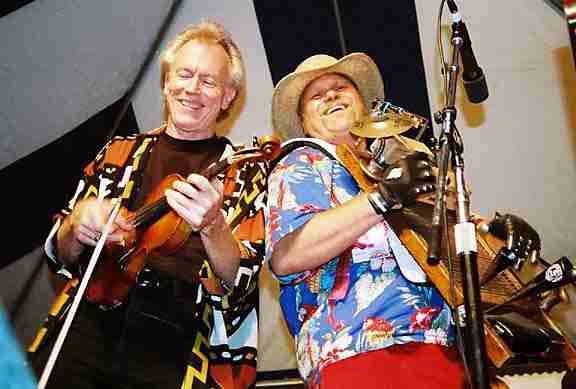| San Francisco Chronicle by Spud Hilton |

The zydeco group Flambeau performs at last year's Sacramento Jazz Jubilee, which includes many genres of poplar music. |
| Music men, women flood River City for annual Jubilee. |
| Strolling through Old Sacramento on Memorial Day weekend is just
asking for auditory whiplash. A barreling "Panama Rag" charges
from the Chautauqua tent on the right. Snap. A mournful "Mood
Indigo" sneaks up from a bistro on the left. Snap. In the alley
ahead, a one-man band with "I'm a Jazz Nut" on his shirt
kazoos and thumps his way through "I Like Bananas Because They Have
No Bones."
It's enough to make a opera-lover's head explode -- and it's everywhere. More than most other large festivals, the Sacramento Jazz Jubilee showcases the city as well as a genre of music. The four-day party with vintage songs, dancing and clothing makes even Old Sacramento look younger. It's the best chance to visit the town when it's dressed up for company and to sample 150 bands playing across the city, from the Sacramento River to State Fair grounds. It's like a weekend in New Orleans, but closer, cleaner, with fewer drunks and, frankly, more authentic early jazz than the "tourist Dixie" that infests the Big Easy nowadays. The festival grew out of a few gigs in 1969 when the fledgling Sacramento Traditional Jazz Society supplied music for fund-raisers to save the Delta King steamboat, which had been moldering at a dock on the Sacramento River. It took four years for the idea to become a committee, but the festival started a year after that, albeit on a smaller scale than the current Jubilee -- just six venues, 19 bands and 5,000 die-hard jazz fans. Two bands -- the Fulton Street Jazz Band and Oregon Jazz Band -- played the first festival in 1974 and in every one since. "The very first year, the main concert site in Old Sacramento was an overgrown vacant lot," said Roger Krum, the festival's executive director. These days the Jubilee draws about 100,000 visitors to 38 stages around the city, including the refurbished Delta King, now a popular hotel and restaurant, and operates with an army of 4,000 volunteers. And the days are long gone when Old Sacramento could contain the growing festival, which has expanded to the Sacramento Convention Center and the California Exposition & State Fair grounds (commonly Cal Expo) and a hotel complex nearby. The Jubilee has expanded in more than just numbers and locations. Since the early '80s, event officials have added variations on traditional jazz or blues almost every year, folding in barbershop, blues, Gospel, Latin jazz, ragtime, swing, western swing and Zydeco. A little modern jazz will even slip in this year. Organizers a few years back even removed the word "Dixieland" from the event name to encourage a bigger audience. (In fairness, almost every large music festival eventually broadens the genre to attract more fans. This year's JazzFest in New Orleans featured Dave Matthews and Elvis Costello.) "It's an event that's celebrating an American art form ... but the focus is on fun," Krum said. "It's not like sitting in a concert hall in a tuxedo." Jubilee or not, Old Sacramento and downtown have plenty of diversions, musical and not, although that was not always so. During the festival's early years, Old Sacramento was still in the middle of a 30-year makeover from crumbling waterfront slum to historic district and tourism magnet. Even as jazz fans filled the streets and cash registers, many storefronts remained vacant. In recent years, however, the transition is both evident and complete. Taking a break from the music and crowds is as easy as ducking into the extraordinary California State Railroad Museum, crossing Capitol Avenue to stroll the new riverfront promenade or browsing among the antique, boutique and novelty shops in the 19th century buildings (although it can seem during the Jubilee that it's impossible to find anything that doesn't say "jazz" on it). The Jubilee also has co-opted the Downtown Plaza shopping mall on K Street, bringing in stages for free performances and, in the process, making the walk from Old Sacramento Town to the Convention Center a musical one. At the east end of the mall, an outside table at the River City Brewing Co. is among the best spots to relax with a pint of stout and a plate of calamari and take in a free show. Tens of thousands of self-avowed jazz fanatics attend the festival religiously, as evidenced by the liberal use of arm garters, flapper dresses, sequined bow ties and straw boaters that light up "I (heart) Jazz!". But every year brings Jubilee neophytes, many baffled by the badges, buses and the prospect of choosing among the more than 1,000 separate performances during the event. According to Krum, newbies should probably start where the festival did. "Pick an area and spend a day there. Let the bands come to you rather than try to run around the various performance areas around town," he said. "Probably Old Sac is the best place. Then, venture out." The very first step, however, is to pick up the festival program and read it cover to cover. That way you can choose your whiplash. |